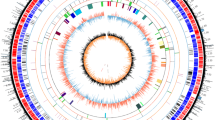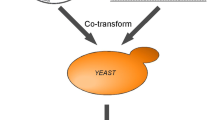Abstract
The clustered regularly interspaced short palindromic repeat (CRISPR)-Cas system has emerged as the dominating tool for genome engineering, while also changes the speed and efficiency of metabolic engineering in conventional and non-conventional yeasts. Among these CRISPR-Cas systems, CRISPR-Cas9 technology has usually been applied for removing unfavorable target genes. Here, we used CRISPR-Cas9 technology to delete the gal80 gene in uracil-deficient strain and had successfully remolded the engineered Saccharomyces cerevisiae that can produce artemisinic acid without galactose induction. An L9(34) orthogonal test was adopted to investigate the effects of different factors on artemisinic acid production. Fermentation medium III with sucrose as carbon sources, 1% inoculum level, and 84-h culture time were identified as the optimal fermentation conditions. Under this condition, the maximum artemisinic acid production by engineered S. cerevisiae 1211-2 was 740 mg/L in shake-flask cultivation level. This study provided an effective approach to reform metabolic pathway of artemisinic acid-producing strain. The engineered S. cerevisiae 1211-2 may be applied to artemisinic acid production by industrial fermentation in the future.



Similar content being viewed by others
Abbreviations
- CRISPR:
-
Clustered regularly interspaced short palindromic repeat
- PAM:
-
Protospacer adjacent motif
- sgRNA:
-
Single-guide RNA
- 5-FOA:
-
5-Fluoroorotic acid
- ura3 :
-
Orotidine-5′-phosphate decarboxylase gene
- gal80 :
-
Galactose metabolism negative regulator
- Gal80:
-
Gal4 inhibitor protein
- SD-URA:
-
Synthetic dextrose minimal medium without uracil
References
Tu Y (2016) Artemisinin—a gift from traditional Chinese medicine to the world (Nobel Lecture). Angew Chem Int Ed Engl 55(35):10210–10226. https://doi.org/10.1002/anie.201601967
Tu Y (2011) The discovery of artemisinin (Qinghaosu) and gifts from Chinese medicine. Nat Med 17(10):1217–1220. https://doi.org/10.1038/nm.2471
South Africa Department of Health (2002) Guidelines for the treatment of malaria in South Africa. Department of Health, Pretoria
Schmid G, Hofheinz M (1983) Total synthesis of Qinghaosu. J Am Chem Soc 105:624–625
Levesque F, Seeberger PH (2012) Continuous-flow synthesis of the anti-malaria drug artemisinin. Angew Chem Int Ed Engl 51(7):1706–1709. https://doi.org/10.1002/anie.201107446
Amara Z, Bellamy JFB, Horvath R, Miller SJ, Beeby A, Burgard A, Rossen K, Poliakoff M, George MW (2015) Applying green chemistry to the photochemical route to artemisinin. Nat Chem 7(6):489–495. https://doi.org/10.1038/nchem.2261
Martin VJ, Pitera DJ, Withers ST, Newman JD, Keasling JD (2003) Engineering a mevalonate pathway in Escherichia coli for production of terpenoids. Nat Biotechnol 21(7):796–802. https://doi.org/10.1038/nbt833
Paddon CJ, Keasling JD (2014) Semi-synthetic artemisinin: a model for the use of synthetic biology in pharmaceutical development. Nat Rev Microbiol 12(5):355–367. https://doi.org/10.1038/nrmicro3240
Paddon CJ, Westfall PJ, Pitera DJ, Benjamin K, Fisher K, McPhee D, Leavell MD, Tai A, Main A, Eng D, Polichuk DR, Teoh KH, Reed DW, Treynor T, Lenihan J, Fleck M, Bajad S, Dang G, Dengrove D, Diola D, Dorin G, Ellens KW, Fickes S, Galazzo J, Gaucher SP, Geistlinger T, Henry R, Hepp M, Horning T, Iqbal T, Jiang H, Kizer L, Lieu B, Melis D, Moss N, Regentin R, Secrest S, Tsuruta H, Vazquez R, Westblade LF, Xu L, Yu M, Zhang Y, Zhao L, Lievense J, Covello PS, Keasling JD, Reiling KK, Renninger NS, Newman JD (2013) High-level semi-synthetic production of the potent antimalarial artemisinin. Nature 496(7446):528–532. https://doi.org/10.1038/nature12051
Ro DK, Paradise EM, Ouellet M, Fisher KJ, Newman KL, Ndungu JM, Ho KA, Eachus RA, Ham TS, Kirby J, Chang MC, Withers ST, Shiba Y, Sarpong R, Keasling JD (2006) Production of the antimalarial drug precursor artemisinic acid in engineered yeast. Nature 440(7086):940–943. https://doi.org/10.1038/nature04640
Shiba Y, Paradise EM, Kirby J, Ro DK, Keasling JD (2007) Engineering of the pyruvate dehydrogenase bypass in Saccharomyces cerevisiae for high-level production of isoprenoids. Metab Eng 9(2):160–168. https://doi.org/10.1016/j.ymben.2006.10.005
Westfall PJ, Pitera DJ, Lenihan JR, Eng D, Woolard FX, Regentin R, Horning T, Tsuruta H, Melis DJ, Owens A, Fickes S, Diola D, Benjamin KR, Keasling JD, Leavell MD, McPhee DJ, Renninger NS, Newman JD, Paddon CJ (2012) Production of amorphadiene in yeast, and its conversion to dihydroartemisinic acid, precursor to the antimalarial agent artemisinin. Proc Natl Acad Sci USA 109(3):E111–E118. https://doi.org/10.1073/pnas.1110740109
Bhat PJ, Murthy TV (2001) Transcriptional control of the GAL/MEL regulon of yeast Saccharomyces cerevisiae: mechanism of galactose-mediated signal transduction. Mol Microbiol 40(5):1059–1066
Lohr D, Venkov P, Zlatanova J (1995) Transcriptional regulation in the yeast GAL gene family: a complex genetic network. FASEB J 9(9):777–787
Soreanu I, Hendler A, Dahan D, Dovrat D, Aharoni A (2018) Marker-free genetic manipulations in yeast using CRISPR/CAS9 system. Curr Genet 64(5):1129–1139. https://doi.org/10.1007/s00294-018-0831-y
Zhang GC, Kong II, Kim H, Liu JJ, Cate JH, Jin YS (2014) Construction of a quadruple auxotrophic mutant of an industrial polyploid Saccharomyces cerevisiae strain by using RNA-guided Cas9 nuclease. Appl Environ Microbiol 80(24):7694–7701. https://doi.org/10.1128/AEM.02310-14
Mougiakos I, Bosma EF, Ganguly J, van der Oost J, van Kranenburg R (2018) Hijacking CRISPR-Cas for high-throughput bacterial metabolic engineering: advances and prospects. Curr Opin Biotechnol 50:146–157. https://doi.org/10.1016/j.copbio.2018.01.002
Fraczek MG, Naseeb S, Delneri D (2018) History of genome editing in yeast. Yeast 35(5):361–368. https://doi.org/10.1002/yea.3308
Lian J, Mishra S, Zhao H (2018) Recent advances in metabolic engineering of Saccharomyces cerevisiae: new tools and their applications. Metab Eng 50:85–108. https://doi.org/10.1016/j.ymben.2018.04.011
Reider Apel A, d’Espaux L, Wehrs M, Sachs D, Li RA, Tong GJ, Garber M, Nnadi O, Zhuang W, Hillson NJ, Keasling JD, Mukhopadhyay A (2017) A Cas9-based toolkit to program gene expression in Saccharomyces cerevisiae. Nucleic Acids Res 45(1):496–508. https://doi.org/10.1093/nar/gkw1023
Raschmanova H, Weninger A, Glieder A, Kovar K, Vogl T (2018) Implementing CRISPR-Cas technologies in conventional and non-conventional yeasts: current state and future prospects. Biotechnol Adv 36(3):641–665. https://doi.org/10.1016/j.biotechadv.2018.01.006
Besada-Lombana PB, McTaggart TL, Da Silva NA (2018) Molecular tools for pathway engineering in Saccharomyces cerevisiae. Curr Opin Biotechnol 53:39–49. https://doi.org/10.1016/j.copbio.2017.12.002
Laughery MF, Hunter T, Brown A, Hoopes J, Ostbye T, Shumaker T, Wyrick JJ (2015) New vectors for simple and streamlined CRISPR-Cas9 genome editing in Saccharomyces cerevisiae. Yeast 32(12):711–720. https://doi.org/10.1002/yea.3098
DiCarlo JE, Norville JE, Mali P, Rios X, Aach J, Church GM (2013) Genome engineering in Saccharomyces cerevisiae using CRISPR-Cas systems. Nucleic Acids Res 41(7):4336–4343. https://doi.org/10.1093/nar/gkt135
Ronda C, Maury J, Jakociunas T, Jacobsen SA, Germann SM, Harrison SJ, Borodina I, Keasling JD, Jensen MK, Nielsen AT (2015) CrEdit: CRISPR mediated multi-loci gene integration in Saccharomyces cerevisiae. Microb Cell Factories 14:97. https://doi.org/10.1186/s12934-015-0288-3
Jakociunas T, Jensen ED, Jensen MK, Keasling JD (2018) Assembly and multiplex genome integration of metabolic pathways in yeast using CasEMBLR. Methods Mol Biol 1671:185–201. https://doi.org/10.1007/978-1-4939-7295-1_12
Paradise EM, Kirby J, Chan R, Keasling JD (2008) Redirection of flux through the FPP branch-point in Saccharomyces cerevisiae by down-regulating squalene synthase. Biotechnol Bioeng 100(2):371–378. https://doi.org/10.1002/bit.21766
Gietz RD, Schiestl RH (2007) Quick and easy yeast transformation using the LiAc/SS carrier DNA/PEG method. Nat Protoc 2(1):35–37. https://doi.org/10.1038/nprot.2007.14
Kaneko S, Tanaka T, Noda H, Fukuda H, Akada R, Kondo A (2009) Marker-disruptive gene integration and URA3 recycling for multiple gene manipulation in Saccharomyces cerevisiae. Appl Microbiol Biotechnol 83(4):783–789. https://doi.org/10.1007/s00253-009-2038-0
Murakami N, Miyoshi S, Yokoyama R, Hoshida H, Akada R, Ogata T (2012) Construction of a URA3 deletion strain from the allotetraploid bottom-fermenting yeast Saccharomyces pastorianus. Yeast 29(5):155–165. https://doi.org/10.1002/yea.2897
Choudhury BI, Whiteway M (2018) Evolutionary transition of GAL regulatory circuit from generalist to specialist function in Ascomycetes. Trends Microbiol 26(8):692–702. https://doi.org/10.1016/j.tim.2017.12.008
Pannala VR, Bhat PJ, Bhartiya S, Venkatesh KV (2010) Systems biology of GAL regulon in Saccharomyces cerevisiae. Wiley Interdiscip Rev Syst Biol Med 2(1):98–106. https://doi.org/10.1002/wsbm.38
Peng B, Wood RJ, Nielsen LK, Vickers CE (2018) An expanded heterologous GAL promoter collection for diauxie-inducible expression in Saccharomyces cerevisiae. ACS Synth Biol 7(2):748–751. https://doi.org/10.1021/acssynbio.7b00355
Cong L, Ran FA, Cox D, Lin S, Barretto R, Habib N, Hsu PD, Wu X, Jiang W, Marraffini LA, Zhang F (2013) Multiplex genome engineering using CRISPR/Cas systems. Science 339(6121):819–823. https://doi.org/10.1126/science.1231143
Mali P, Yang L, Esvelt KM, Aach J, Guell M, DiCarlo JE, Norville JE, Church GM (2013) RNA-guided human genome engineering via Cas9. Science 339(6121):823–826. https://doi.org/10.1126/science.1232033
Generoso WC, Gottardi M, Oreb M, Boles E (2016) Simplified CRISPR-Cas genome editing for Saccharomyces cerevisiae. J Microbiol Methods 127:203–205. https://doi.org/10.1016/j.mimet.2016.06.020
Jessop-Fabre MM, Jakociunas T, Stovicek V, Dai Z, Jensen MK, Keasling JD, Borodina I (2016) EasyClone-MarkerFree: a vector toolkit for marker-less integration of genes into Saccharomyces cerevisiae via CRISPR-Cas9. Biotechnol J 11(8):1110–1117. https://doi.org/10.1002/biot.201600147
Nehlin JO, Carlberg M, Ronne H (1991) Control of yeast GAL genes by MIG1 repressor: a transcriptional cascade in the glucose response. EMBO J 10(11):3373–3377
Acknowledgements
This research was supported by grants from the Drug Innovation Major Project (2017ZX09101002-003-003 and 2018ZX09711001-007-003), National Key Research and Development Program of China (2018YFA0902000), and National Natural Science Foundation of China (31870059).
Author information
Authors and Affiliations
Corresponding authors
Ethics declarations
Conflict of interest
The authors declare that they have no conflict of interest.
Additional information
Publisher's Note
Springer Nature remains neutral with regard to jurisdictional claims in published maps and institutional affiliations.
Electronic supplementary material
Below is the link to the electronic supplementary material.
Rights and permissions
About this article
Cite this article
Ai, L., Guo, W., Chen, W. et al. The gal80 Deletion by CRISPR-Cas9 in Engineered Saccharomyces cerevisiae Produces Artemisinic Acid Without Galactose Induction. Curr Microbiol 76, 1313–1319 (2019). https://doi.org/10.1007/s00284-019-01752-2
Received:
Accepted:
Published:
Issue Date:
DOI: https://doi.org/10.1007/s00284-019-01752-2




